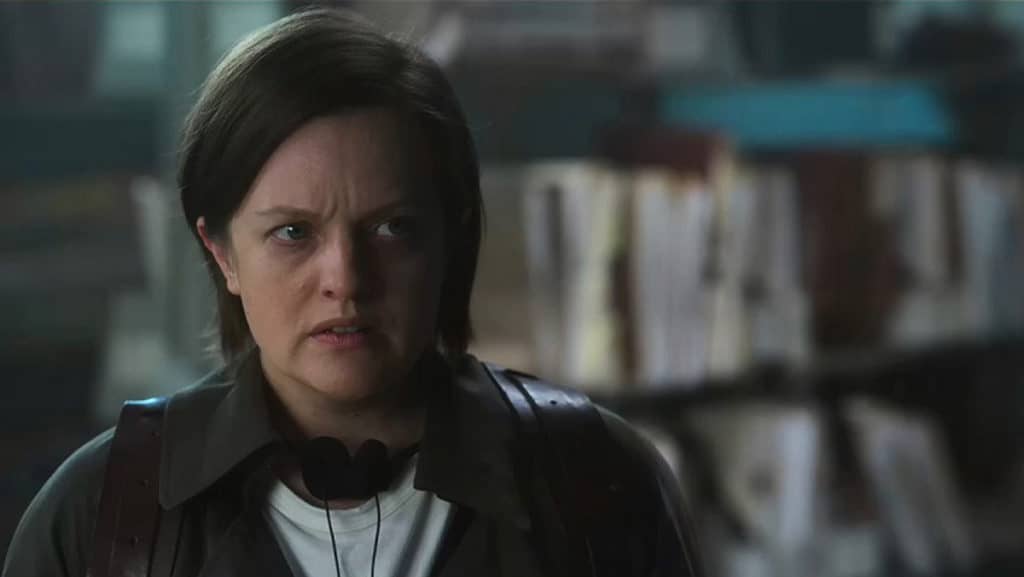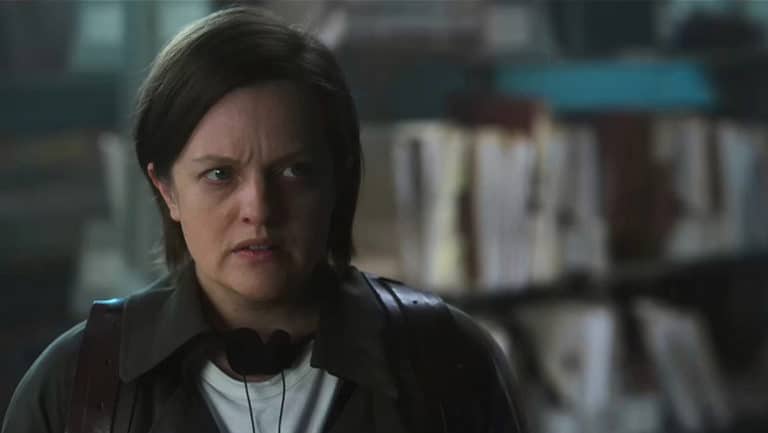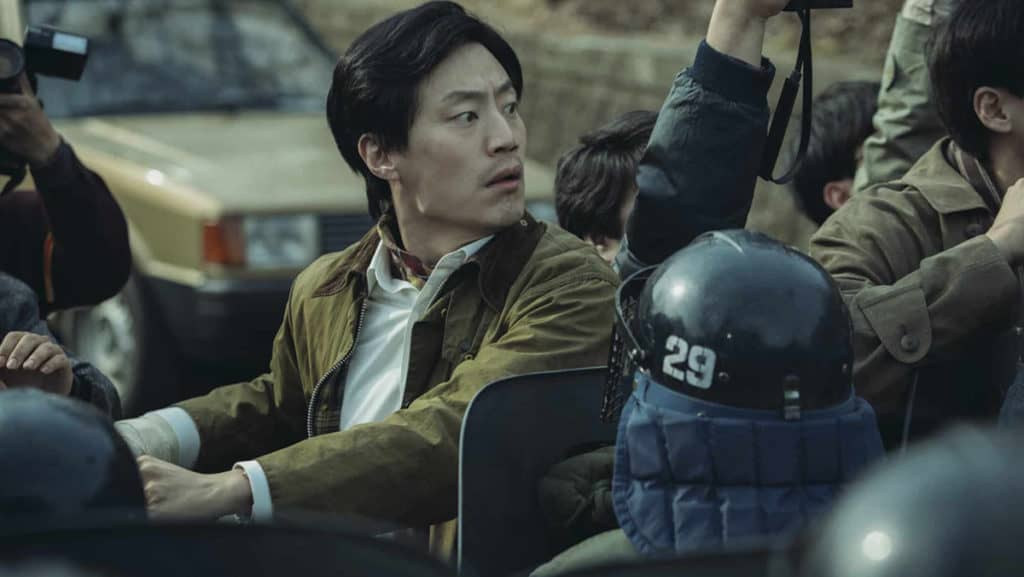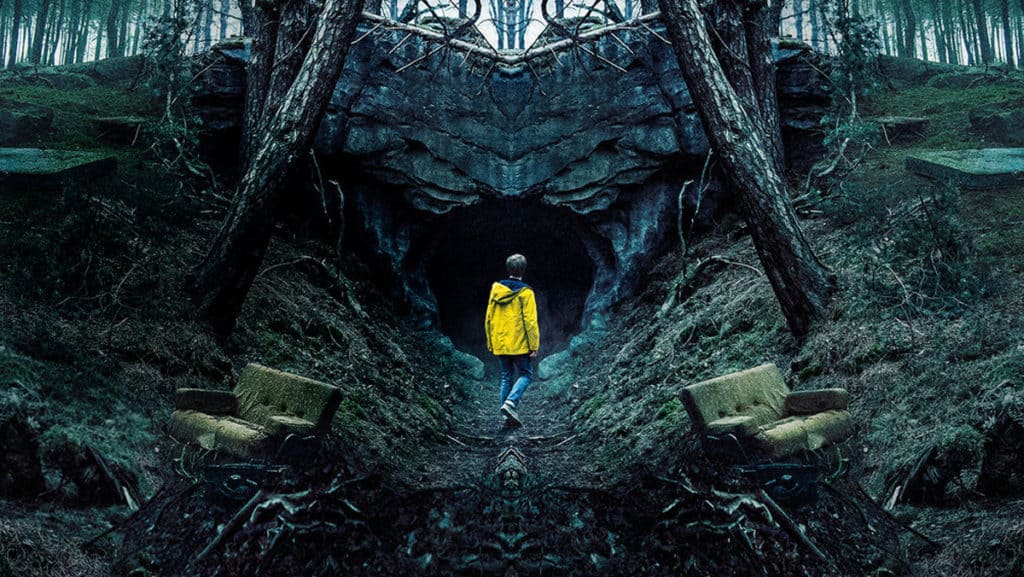From the very beginning of the series, the story establishes an unsettling atmosphere. When Harper (Jamie Bell) sits beside a little girl in 1964, talking to her about reliving this moment and the future, it is immediately clear that something is not right. Shining Girls is a mystery series about a serial killer, but it makes it clear from the outset that the mystery is neither about the killer’s identity nor the method of murder. From the very beginning, you already know who the killer is. The real mystery lies in the motive behind the murders and how they are interconnected across different time periods. These murders, spanning decades apart, follow an eerily identical pattern, creating a temporal enigma rather than a conventional whodunit. Throughout the story, reality is in a constant state of flux. The butterfly effect is at play, as actions in the past—ones the viewer is yet to discover—continuously alter the present. As a result, Kirby suddenly finds herself living in a different apartment, or even married. Her hairstyle shifts from one moment to the next, subtly but unmistakably changing.
For instance, in the second episode, Harper (Jamie Bell) sits at a table with a brown coffee mug while reading the newspaper. Yet, when he lifts the mug again, it has turned white. These subtle and overt shifts are not mere continuity errors but an intrinsic part of the narrative, reinforcing the story’s unsettling and unpredictable nature Throughout the story, you witness events unfolding across different points in time. You are thrown from the past to the future, then back to the present, yet despite these shifts, the scenes—each with its own unique timeline—are intricately connected when placed in sequence. The linear structure of the story is fragmented! Everything happens simultaneously, which is why you can see a woman who has been murdered and then, moments later, see her alive again. This constant temporal disorientation ensures that the audience can never be entirely certain of when they are in the narrative, reinforcing the show’s eerie, mind-bending atmosphere.
As Twin Peaks and True Detective have demonstrated, it is not impossible for a serialized drama to blend violence with an elaborate metaphysical concept while maintaining its human element. However, Shining Girls fails to fuse these contrasting aspects effectively, resulting in a narrative imbalance that ultimately leaves the viewer with little clarity about what is truly unfolding in the core storyline. Although the concept of trauma across different time periods is a strong foundation for an engaging story, here, it is merely touched upon rather than deeply explored. The series attempts to address themes such as patriarchy, journalistic integrity, and family conflicts, yet these elements fail to create compelling dramatic tension—let alone offer fresh insights.
Based on the bestselling novel of the same name by Lauren Beukes, Shining Girls begins with a seemingly straightforward premise: serial murders. But as the story progresses, it becomes clear that this is far from a simple, linear crime thriller. Instead, we find ourselves on the brink of a severe temporal disarray, where time itself collapses into an unsettling and fragmented reality.
Many mystery films about serial killers have been made, often relying on the complexity of uncovering the killer’s identity to drive their narratives forward. However, Shining Girls is more than just a cat-and-mouse story. The creators aim to depict the very nature of violence and trauma—how they can fracture reality itself.
Significant events in a person’s life can sometimes make the world around them feel unfamiliar and distorted. But what if they actually change the world? This is the very loop that propels Kirby, the protagonist, from one unstable reality to another. Having survived a brutal attack by a serial killer named Harper, she now finds herself trapped in an ever-shifting and perplexing existence—one that is as difficult for her to comprehend as it is for the audience. Some of these changes are minor, like tasting a sandwich she has never had before or her hairstyle subtly shifting from moment to moment. But others are far more profound—changes that radically alter the course of her life, such as her marital status or her professional position. Although the story is carefully layered, it suffers from a weak opening. The first episode is undoubtedly the weakest of the series—confusing, poorly executed, and incapable of handling the weight of such a complex narrative. It’s the kind of start that could easily discourage viewers from continuing. The major flaw is that the story begins with Kirby, a protagonist who is already lost. This sense of disorientation transfers directly to the audience, as it stems from Kirby’s constant shifts in time and space. Additionally, Elizabeth Moss’s performance leans heavily into the psychological aspects of the character, which, while effective later on, contributes to the initial confusion.
However, as the story progresses, it becomes increasingly engaging. By episodes four and five, the viewer is fully immersed in the mystery, and from episode six onward, the puzzle pieces begin falling into place, culminating in a satisfying payoff. Shining Girls feels like a fusion of Zodiac (David Fincher) and The Butterfly Effect (Eric Bress and J. Mackye Gruber). The protagonist, Kirby (Elizabeth Moss), survives a brutal attack by a serial killer, only to find herself drifting between different timelines ever since. In one version of her life, she lives with her mother and works as an archivist at the Chicago Sun-Times. In another, she is married to a colleague and has become a journalist at the same newspaper. When the body of a woman is discovered, bearing injuries eerily similar to hers, Kirby realizes that the killer is the same man who once tried to take her life. She embarks on an investigation alongside her colleague, Dan Velazquez (Wagner Moura), who proves himself to be far more capable than the version of him audiences may remember from his role as Pablo Escobar in Narcos. Together, they set out to track down Harper and uncover the terrifying truth behind his murders.
Ever since Dr. Emmett Brown sketched his theory on a chalkboard in Back to the Future Part II, countless films and TV series have explored the concept of time travel and parallel worlds, transforming it into a full-fledged genre filled with intricate narratives and boundary-defying storytelling. A series like Dark fully embraces this premise, weaving an elaborate web of timelines and paradoxes. However, Shining Girls takes a different approach, using its time-warping elements to explore the psychological aftermath of trauma and its enduring impact on survivors. In this series, trauma itself takes on a cinematic form, shaping the very fabric of reality.
From an aesthetic standpoint, Shining Girls successfully crafts an atmosphere and tone that complement its unsettling narrative. Claudia Sarne’s hauntingly effective score weaves an invisible thread through the fragmented storyline, binding its scattered pieces into a cohesive whole—a remarkable achievement that elevates the series. The visual effects are also top-notch. The production design is meticulously crafted, with richly detailed sets that allow the camera to fully immerse itself in the film’s geography, adding depth and authenticity to its world.
The story revolves around a woman named Kirby, who survives a brutal attack only to find herself caught in a series of metaphysical disturbances that even she struggles to comprehend. She is adrift between multiple realities, experiencing inexplicable shifts that challenge her sense of self and stability. In an attempt to regain control, she starts documenting every detail of her life in a notebook, trying to anchor herself amidst the chaos. Gradually, she realizes that certain elements remain constant while others change unpredictably. The problem, however, is that these so-called “constants” are anything but reliable—small and large alterations continuously distort her perception of what is real and what is not, leaving her in a perpetual state of uncertainty.
At the center of it all is Elizabeth Moss (Kirby), once again portraying a woman on the brink of collapse—without any fear of being typecast. If anything, playing traumatized, damaged women seems to be what pushes her craft forward, and she continues to excel in every new role. Here, she embodies Kirby, a woman living in the 1990s and working at a newspaper. She appears withdrawn and isolated, though the audience quickly understands she has every reason to be. Years ago, she was attacked and brutally assaulted by a serial killer, surviving against all odds. But her life has since been irreversibly altered—her disorienting experience of shifting through time being one of the most perplexing consequences. Yet, despite the instability, she is determined to find her attacker—a criminal who is still out there, active and dangerously present.
As the timelines begin to merge, it becomes clear that the only person who might be able to untangle this mystery is an investigative journalist whose relentless drive might just be enough to stop a violent killer. Enter Dan Velazquez, whose own past is shrouded in darkness. Together, he and Kirby attempt to piece together the puzzle, and as their partnership unfolds, the audience gradually gathers more clues. However, Harper always seems to be one step ahead.
Jamie Bell delivers an exceptional performance as Harper, crafting a character that feels disturbingly real. His portrayal is chillingly effective, and it’s fascinating to see him take on a role so drastically different from what audiences have come to expect from him. His transformation into such a menacing, unpredictable figure is nothing short of impressive.
Shining Girls is a brilliant narrative that explores how trauma can reshape reality itself. Elizabeth Moss, one of the finest actresses of her generation, brings her signature intensity to a role that demands both vulnerability and resilience. Few actors can inhabit such an eerie and disorienting world as convincingly as she does. Meanwhile, Jamie Bell delivers one of the strongest performances of his career, fully embodying Harper—a former soldier turned serial killer. Unlike the archetypal murderer who lurks in the shadows, Harper operates in plain sight, stalking his victims with a chilling confidence that rivals Christian Bale’s portrayal in American Psycho.
The way the characters’ pasts intertwine with the present is handled in an engaging manner. Events often repeat themselves in different variations, but rather than becoming monotonous, these recurrences enhance the audience’s understanding of the story’s complexities. Additionally, the visual style perfectly complements the show’s dark themes. The color palette leans toward cold tones, but this bleakness never overwhelms the atmosphere. Instead, it subtly reinforces the unsettling nature of the narrative, creating a world where reality constantly shifts yet remains disturbingly tangible.
Complexity is the defining trait of Shining Girls—a layered intricacy that enriches the narrative rather than overwhelming it. At times, due to the element of time travel, certain events may seem almost too coincidental, but ultimately, the ever-present tension dominates the atmosphere, successfully keeping the viewer on edge.
The series carefully builds a sequence of events that gradually transforms its characters, shaping their arcs with each unsettling shift in reality. And at the heart of it all is Kirby—who, through this labyrinth of trauma and distortion, ultimately finds the strength to reclaim control over herself and her fate.





